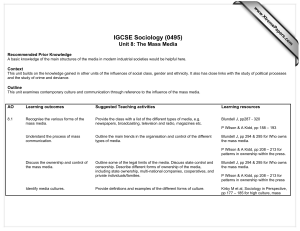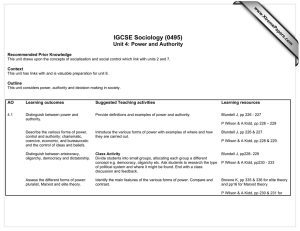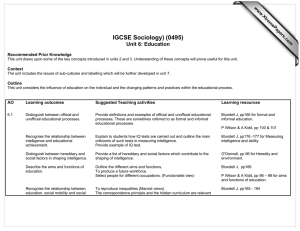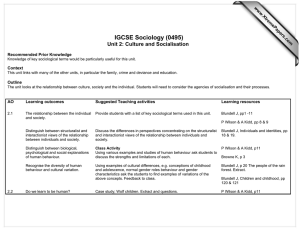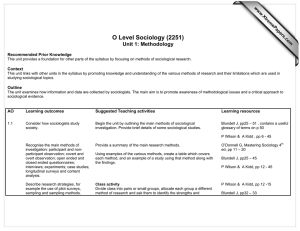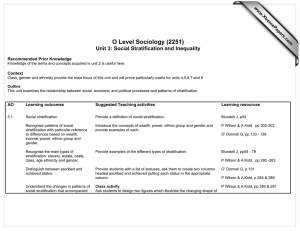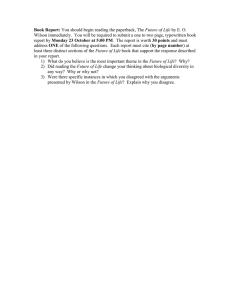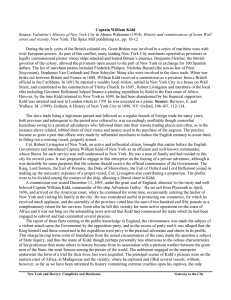O Level Sociology (2251) Unit 4: Power and Authority www.XtremePapers.com
advertisement
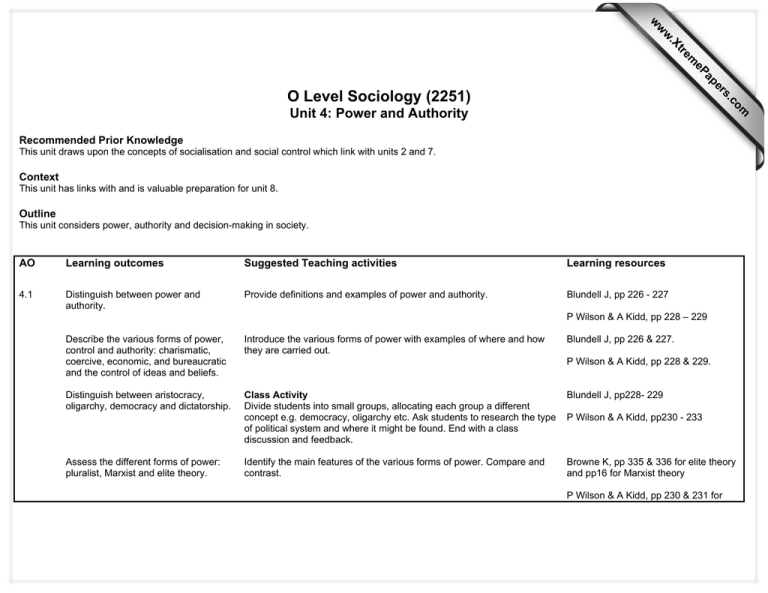
s er ap eP m e tr .X w w w om .c O Level Sociology (2251) Unit 4: Power and Authority Recommended Prior Knowledge This unit draws upon the concepts of socialisation and social control which link with units 2 and 7. Context This unit has links with and is valuable preparation for unit 8. Outline This unit considers power, authority and decision-making in society. AO Learning outcomes Suggested Teaching activities Learning resources 4.1 Distinguish between power and authority. Provide definitions and examples of power and authority. Blundell J, pp 226 - 227 P Wilson & A Kidd, pp 228 – 229 Describe the various forms of power, control and authority: charismatic, coercive, economic, and bureaucratic and the control of ideas and beliefs. Introduce the various forms of power with examples of where and how they are carried out. Distinguish between aristocracy, oligarchy, democracy and dictatorship. Class Activity Divide students into small groups, allocating each group a different concept e.g. democracy, oligarchy etc. Ask students to research the type of political system and where it might be found. End with a class discussion and feedback. Blundell J, pp228- 229 Identify the main features of the various forms of power. Compare and contrast. Browne K, pp 335 & 336 for elite theory and pp16 for Marxist theory Assess the different forms of power: pluralist, Marxist and elite theory. Blundell J, pp 226 & 227. P Wilson & A Kidd, pp 228 & 229. P Wilson & A Kidd, pp230 - 233 P Wilson & A Kidd, pp 230 & 231 for pluralist theory. 4.2 Compare differing interpretations of the role of the State in contemporary societies. Class debate. Provide students with different interpretations of the role of the state in modern societies. P Wilson & A Kidd, pp 232 & 233 for contrasting views of the state Recognise who makes and influences political decisions. Class activity Divide students into small groups; allocate one influence on political decisions to each group, e.g. social class, gender, ethnicity, age or religion. Ask the group to come up with a list of characteristics which influence their category. Blundell J, pp 242 – 247 for class, gender and ethnicity. Distinguish between democratic and authoritarian forms of power. Provide definitions and examples of authoritarian and democratic power. Invite the students to compose a list of the main differences between these two forms of power. P Wilson & A Kidd, pp240 - 243 Blundell J, pp 228 & 229 for forms of power. P Wilson & A Kidd, pp228 – 231 Understand the political processes in the students’ own society and at least one other contrasting society. Outline the main sources of power and influence in your own society. Recognise the role of political parties and pressure groups. In small groups ask students to use various resources to describe one political party and one pressure group in modern industrial society. Blundell J, pp 226 P Wilson & A Kidd, p 228 Blundell J, pp 234 – 237 for descriptions of political parties. O’Donnell G, pp 357 – 365 for good chapter on pressure groups. P Wilson & A Kidd, pp 234 – 253 Discuss the links between political socialisation and the media. Demonstrate how political parties use the mass media; include TV and radio broadcasting, newspapers and the use of celebrity role models. O’Donnell G, pp 372 for the influence of the media and political socialisation. Describe the factors that influence voting behaviour and the influence of opinion polls on the political process. Identify the main factors that influence voting behaviour. Blundell J, pp240 – 243 Class activity Browne K, pp 128 – 143 for influences Ask students to conduct their own opinion poll among other students in order to find out how they would vote in an election to decide the next government. Compare the findings with other members of the class. Discuss the concepts of freedom and censorship. Using real life examples discuss the concepts of freedom and censorship. It is useful and interesting to examine the concepts of freedom and censorship in the media at national or local levels. on voting behaviour. P Wilson & A Kidd, pp 234 – 243 for the role of elections and the political process. Browne K, p 147 for limits to the media’s freedom & p 172 – 173 for debate on democracy. P Wilson & A Kidd, pp 210-213 for freedom of the press.
